 |
| Greta Gerwig |
Greta
Gerwig
On bringing little women to big screens
After winning us over with her naturalistic performances in offbeat independent films, Greta Gerwig stepped behind the camera to write and direct the wholehearted, female-forward favourites Lady Bird and Little Women. In the process, the Sacramento-born star became a multiple Oscar contender — one of only five women to be nominated for best director — and a cinematic force to be reckoned with. Now, at 39, she’s set to tackle her biggest subject yet: a doll called Barbie. And none of us can wait.
 |
“What we’ve come to with Barbie is that it is authentically artificial,” Greta Gerwig says when I ask what she can tell me about the biggest, most anticipated film of the year. “I’m a big believer that in movies everything is everything – that if you attach onto something early, then that’s true of the costumes, it’s true of the acting and it’s true of the music. It’s a catchphrase that seemed to apply to everything: that it’s fake, but it’s really fake. Like a painted sky.”
Given the public’s huge presumptive obsession with Barbie, there’s a kind of moral imperative to ask its director about it immediately. This is true even while knowing that almost everything regarding the film is a jealously guarded secret, beyond blockbuster casting details such as Margot Robbie as you-know-who and Ryan Gosling as Ken. (Shots of the pair rollerblading down Venice Beach in character went viral last year, not least because of their outfits: a Day-Glo homage to the absurder edges of 1980s athleisure, complete with matching fluorescent knee and elbow pads.)
But the world’s most famous doll also feels like an incongruous subject, set against Greta’s wider reputation as a filmmaker. Her two previous solo directing projects, 2017’s Lady Bird and 2019’s Little Women, were respectively a tender coming-of-age drama and an experimental, feminist adaptation of a 19th-century novel. Those films found huge, devoted audiences, received 11 Oscar nomin-ations between them and established Greta as one of the most original and important directors at work today. They also felt totally of a piece with her previous work as an actor and co-writer on films that arrived in the vicinity of terms like “naturalistic” and “independent”. What could the live-action realisation of Mattel’s multibillion-dollar franchise have to do with those sensibilities? It’s a question that has led to much giddiness since Greta was announced as Barbie’s director back in the summer of 2021.
Greta is sitting, as we speak, at home in Manhattan, in the apartment where she lives with her partner, the director Noah Baumbach (in whose film White Noise she has just starred alongside Adam Driver), and their three-year-old son, Harold. Seven months pregnant, she’s wearing maternity overalls with a black roll-neck jumper. The room is painted white, with a trio of framed black-and-white photographs resting on a ledge. When I enquire, she tells me they’re on-set images of the Swedish filmmaker Ingmar Bergman and his team. “I love seeing them with their scripts out.” Is the room a study? She has no idea. “Everything’s getting kind of moved around. You always find out you’re having another baby before you have enough room.”
Barbie, she says, belongs absolutely to the same creative path as Lady Bird and Little Women; it’s just another step on a trajectory that also connects indie classics such as Frances Ha (2012) and Mistress America (2015) with her earliest work lighting up mumblecore films in the late 2000s. There has been no detour, no compromise. “Whenever I take something on, whether it’s directing or writing, it hooks into something inside me so it feels like I have to do it,” she says. “I mean, it sounds crazy, because it’s literature versus a doll, but Barbie is not so dissimilar from the process of adapting Little Women – I had such a clear sense of what this thing was that I loved and how I wanted to come at it and change it. Barbie obviously exists bigger than me, but it also exists inside of me, because I remember going to Toys R Us and looking at Barbies when I was a little girl.”
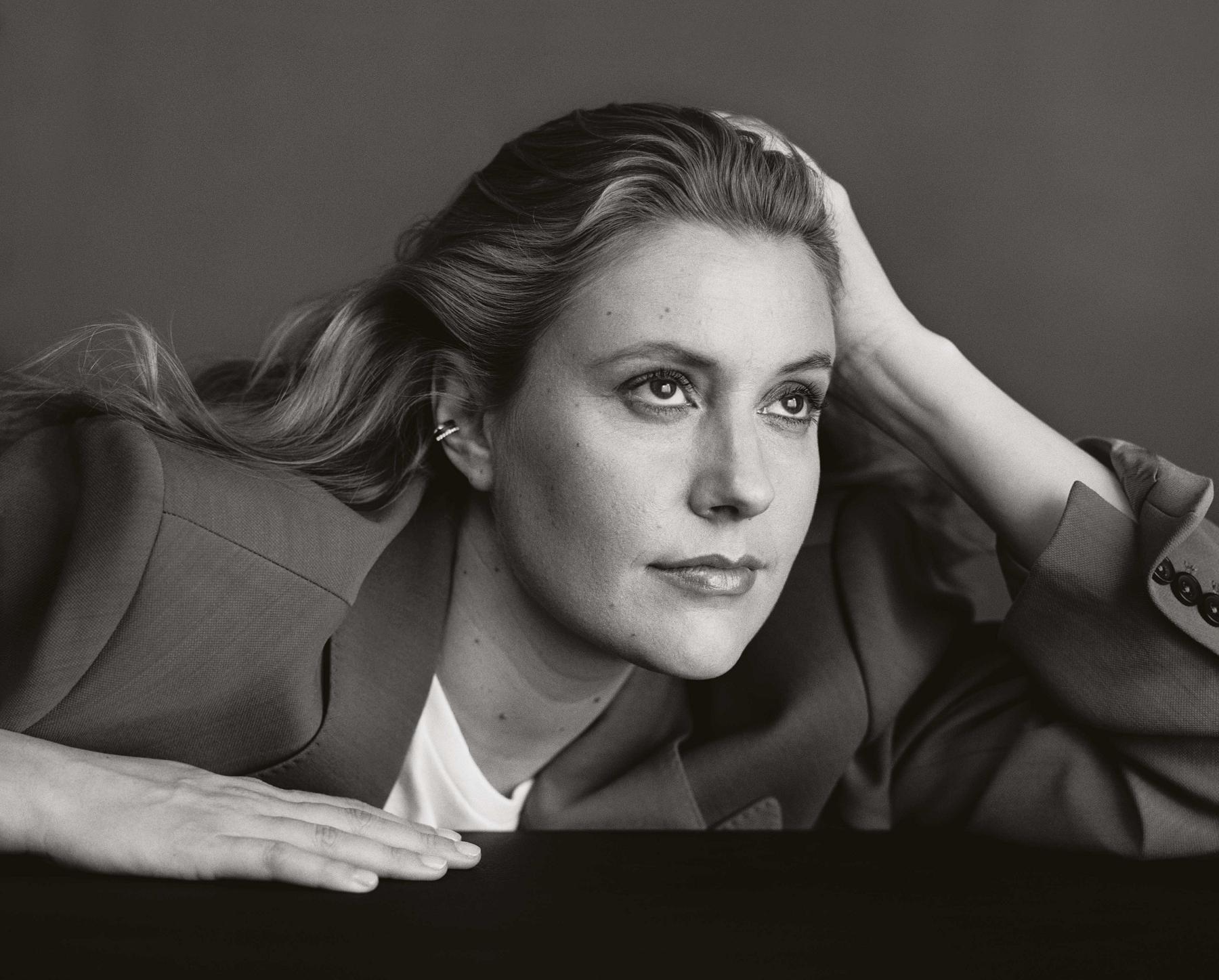
Here and in the opening image, Greta is wearing a flax wool Tanner blazer over a white cotton Mae T-shirt, both by KHAITE. The pink-gold diamond-paved Antifer earcuff, worn throughout, is by REPOSSI.
Like many of the characters she has played, Greta projects a conversational warmth that feels entirely unaffected, and sometimes she comes across like a more self-assured version of those characters. When I try to prod her for details on this or that forbidden topic – the Barbie plot; rumours that she will direct a series of Narnia movies for Netflix – she is loquacious in her absence of an answer, so much so that it doesn’t feel like an absence at all. Her accent, which she tends to carry into acting roles, has a certain woozy quality; there’s a relishing of some syllables, a blurriness around others. Although recognisably Californian, this is not the globalised LA twang we all know but the product of an upbringing some 400 miles north of movieland, in the notably less glamorous state capital, Sacramento. It was in this government town – “a place where you can always see the horizon”, as she’d one day describe it – that Greta Celeste Gerwig was born on Thursday, 4 August, 1983.
Her mother, Christine, worked as a nurse; her father, Gordon, for a credit union for small businesses. She describes them, approvingly, as “a bit hippie”. They had certain principles – no television (“We had a tiny black-and-white set they kept in a closet and brought out only sometimes,” Greta tells me), no logos on clothing – and were adherents of Unitarian Universalism, a liberal religion established in the early 1960s. Barbie was also “discouraged,” Greta says, although eventually “they did actually let that happen a little bit, because the older girls in the neighbourhood would let me have them as hand-me-downs. And I enjoyed it so much… I really do think a big fascination for me was the size of the hair. It was so much hair!” Greta’s father was also a budding musician, and her first memory is of being at the city’s well-known jazz festival. “I must have been somewhere around three, on my grandfather’s lap, being bounced, listening to the music,” she says. “I think I have a sense memory. It’s really hot in Sacramento in the summer. It’s hot, hot, hot. There were these sandals – kids still wear them, but I wore them my whole life. Is it Salt Water sandals? I was wearing Salt Water sandals, and it was dusty.”
It is thanks to Greta’s adolescent memories that Sacramento is now indelibly associated with Lady Bird, which, in 2018, made her only the fifth woman to receive an Oscar nomination for best director (the film’s other four nominations included Best Picture and best original screenplay). Lady Bird tracks the coming-of-age travails of a teenager, played by Saoirse Ronan, as she navigates a constellation of troubled but formative relationships with her mother (Laurie Metcalf), with whom she listens to a John Steinbeck audiobook in the car shortly before flinging herself out the passenger door in protest at the way their conversation is going, and with a pair of early boyfriends, one an archetype of the cool-yet-distant early crush, rendered with infuriating precision by Timothée Chalamet. “Greta genuinely gets excited about making movies,” Saoirse Ronan says in an email correspondence from London, where she is working on Steve McQueen’s Blitz. “She is not pretentious in any way, just really smart. Book-smart and people-smart – a rare combination.”
The critic Mark Kermode first became aware of Greta when she was thought of as the queen of mumblecore, he tells me by email. “It was Frances Ha that moved her into the mainstream. But the real breakthrough was writing and directing Lady Bird,” he says. “She understands how film can be used to tell stories in ways which are both specific and universal. She has done a brilliant job of telling women’s stories on screen, but for me it’s the fact that she seems to understand characters across the board that matters. And she’s clearly terrific with actors – she seems to bring something out in them that perhaps another director would have missed. Her films feel cheeky and subversive, but also oddly heartfelt and personal. I can’t wait to see Barbie.”
Ronan went on to star in Little Women, which, despite being the seventh movie adaptation of Louisa May Alcott’s beloved 1868 novel, found a new way to approach it via the introduction of a back-and-forth timeline and fast pace. In a joint interview with The Hollywood Reporter, Ronan and Greta pledged that they’d become “old ladies together making movies about old ladies”, so it’s fair to say there’s a lot they admire about each other, but Ronan is particularly in awe of Greta’s way with dialogue. “The musicality of it is important to her,” she says. “With the result that her films have an energy that slows and quickens in all the right places.”
Although – or perhaps because – her background is in improvisation, Greta knows how to exert precise control. In Little Women, to give a natural feel to conversations between the four March sisters (played by Ronan, Emma Watson, Florence Pugh and Eliza Scanlen), Greta marked the exact points in the script where one line would interrupt the other. “She invests in your performance like the actor she is,” Ronan says. “And for that reason, you feel understood and like there’s someone on your team – resulting in a feeling of invincibility.”
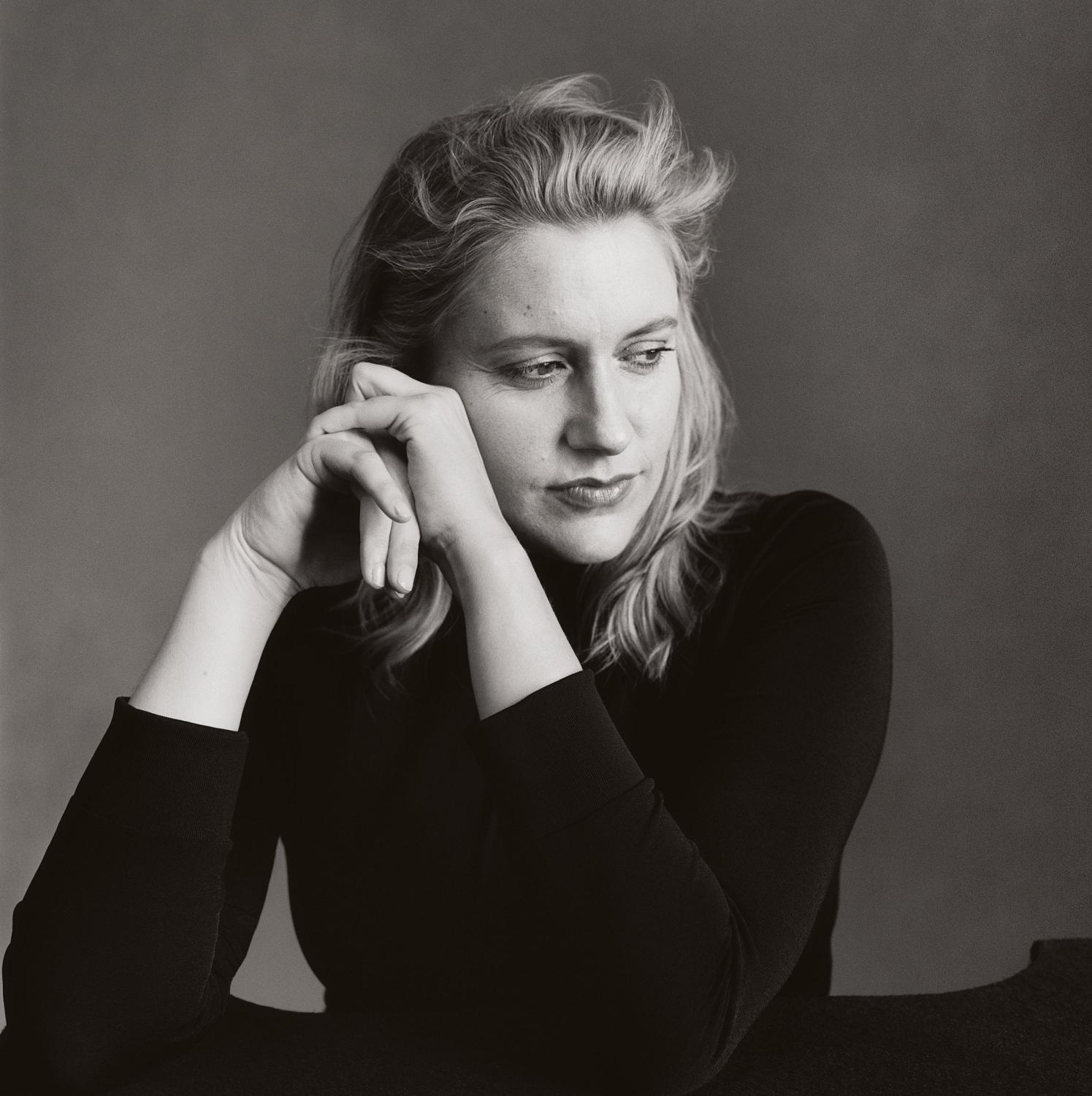
“This makes me sound mystical, but I think movies want to be something. They have their own sense of what they want to be.”
Greta has always loved acting. Her first dream was to be involved in musical theatre, an interest referenced in Lady Bird via its high-school production of Stephen Sondheim’s Merrily We Roll Along. It is also presumably behind a mysterious IMDb entry named only “Untitled Tap Dancing Musical Project”, for which she is listed as director, producer and writer. “I would love to make an original movie musical,” she says. “It’s one of my favourite mediums. There is nothing imminent or concrete; this is years away – or decades away.”
She has been interested, in a serious way, in more mediums than most. As a teenager she played trumpet and danced – “I started out with classical ballet, which was my first love, but I also did tap and jazz and modern and everything” – and she was talented at fencing to the point of competing at the national level. All these past activities have a habit of making cameos in her work. Take the intense trumpet-playing scene in 2007’s Hannah Takes the Stairs (what’s her trumpeting status now? “I have a trumpet upstairs,” she confirms, “but nobody likes a mediocre trumpet player”), or the general physicality on display in roles like that of Abbie, the club-going punk photographer in 2016’s 20th Century Women, directed by Mike Mills.
As for film, it was an interest rather than a passion in the Sacramento years. Video rental outlets were Greta’s primary gateway to movie history (in a podcast interview with Dua Lipa she describes one shop so diligent that it organised even the pornography by director). In college, she watched Beau Travail, Claire Denis’s slow-burning classic about soldiers in the French Foreign Legion, and something fundamental sank in. “I had grown up loving theatre so much, and a lot of the films that I also loved were often adaptations of plays,” she says, “whether it was Howard Hawks or Preston Sturges or Ernst Lubitsch – those things where the filmmaking’s extraordinary but the language is also language. Beau Travail was the first movie I saw that it really clicked, like: Oh, there is a language and a grammar that is specific to film, that is its own.”
Greta applied to study musical theatre but wasn’t accepted (after graduating she applied to do playwriting, but “also got rejected”). In 2002, she went to Barnard, the women’s liberal arts college affiliated with Columbia University, where she majored in English and philosophy. Once there, she found it was possible, thanks to institutional links, to take acting classes with teachers from the Juilliard School, the performing arts college. She went on to appear in Columbia’s prestigious Varsity Show from 2003 to 2005 with her dormmate and friend Kate McKinnon (who until December 2022 was part of the core line-up for Saturday Night Liveand is listed as a cast member for Barbie), as well as founding her own improv group. Greta’s teachers, noticing how often she composed original work, pushed her to explore playwriting as well. “It sounds so silly,” she says. “It just really never occurred to me that I could do it. So I kept doing it but saying I wasn’t doing it, because it felt like not a thing I could do. That gave me protection. If I had had some sort of stress around it I would have not done it.”
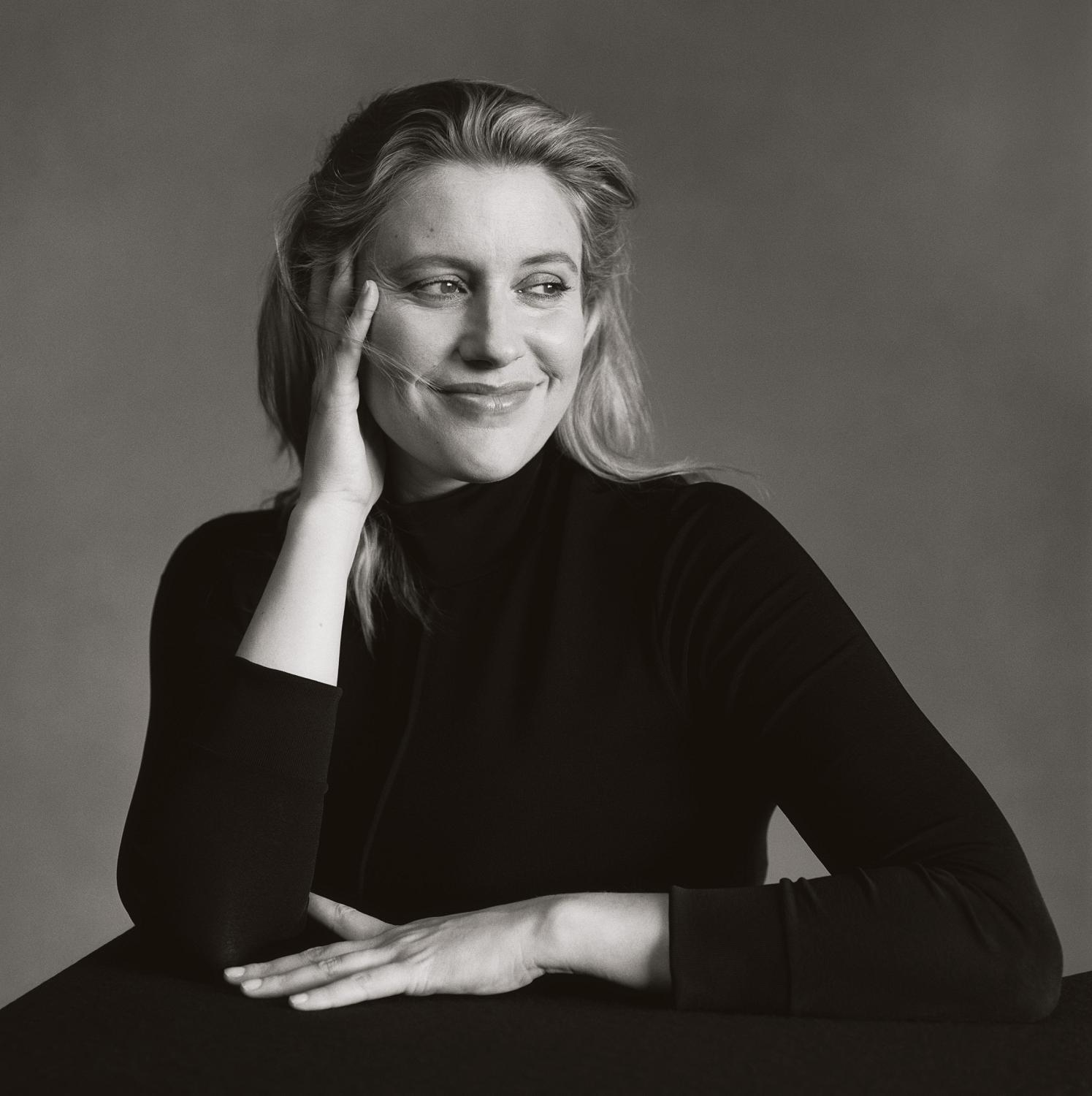
“It sounds crazy, but Barbieis not so dissimilar from the process of adapting Little Women.”
The 2010 film Greenberg opens with a lingering shot of Greta’s face as she drives through LA. Thoughts flicker across her face. “Jet Airliner” by the Steve Miller Band is playing. The scene is quintessentially Greta in the sense that (1) there’s something incredibly unguarded about her, and (2) we instantly feel as if we both know and like her. (Greta’s character goes on to have a fling with Roger Greenberg, a washed-up musician played by Ben Stiller and one of the least likeable people cinema has ever persuaded us to root for.)
That scene marked her first collaboration with Noah Baumbach, who directed Greenberg. When we talk by phone, Baumbach stresses the careful artistry behind what some might mistake for actual effortlessness. “Her just driving around LA – there’s almost a documentary quality to the feeling of it. But you’re watching somebody creating a character for you and being a real author of what she’s doing.”
Greta came to public attention as the breakout star of the mumblecore school of filmmaking, characterised by home-movie-style production values and natur-alistic dialogue. Her first acting credit was for 2006’s LOL, a virtually plotless film about the impact of technology on social relationships. She took on the role after her then-boyfriend befriended its director, Joe Swanberg. She went on to star in Swanberg’s following feature, before co-directing (as well as co-writing and co-starring in) a film with him in the form of 2008’s Nights and Weekends.
Looking back, Greta sees that time as formative but not defining. “I think in a way I was in the process of working out my interests,” she says. “What kind of movies do I want to make? What are the constraints that I like, the things that feel most alive for me? It was kind of fumbling towards that.
“I never really set out to be specifically either independent or experimental, or in one area versus another,” she adds. “It was always that I loved films and I wanted to tell stories, and I’m pretty ecumenical as far as my taste goes. I like big movies, just like everyone, and I like tiny movies, just like a lot of people I know.”
Greta’s subsequent acting career embraced a range of motifs. More often than not, her films involved the kinds of people who watch independent movies, struggle to pay the rent for shared apartments in global cities, and yearn for and believe in the transformative capacity of art. They include what you could call campus-adjacent comedies, from Whit Stillman’s precisely mannered Damsels in Distress (2011) to Rebecca Miller’s Maggie’s Plan (2015), an upside-down romcom in which Greta-as-Maggie tries to get her flailing academic husband (Ethan Hawke) back together with the woman he was previously married to (Julianne Moore). In Pablo Larraín’s Jackie (2016), set during the aftermath of the JFK assassination, Greta’s White House social secretary, Nancy Tuckerman, radiates a kind of unpompous compassion not found elsewhere in the entourage of Natalie Portman’s Jackie Kennedy. (At the 2020 Oscars, Greta’s would be one of eight names embroidered on Portman’s custom-made Dior cape to protest the lack of female best-director nominees.)
Her naturalistic approach to acting gave her an outsize presence in any film she appeared in. It was a technique that extended into certain projects she wrote as well as starred in, notably 2012’s Frances Ha, which she co-wrote with Baumbach and which channelled many of her own memories (especially her refusal to give up in the face of those college rejections) and transposed them onto Frances’ career as a dancer who should actually be a choreographer.
When Greta needs creative advice, it is Baumbach she turns to. He remains her frequent colleague and collaborator, most recently as the co-writer of the Barbie screenplay. “He’s my partner in so many ways,” she says, “and he’s often very wise about everything having to do with making movies.” Baumbach describes them as having a rare writing chemistry. “Writing’s always hard no matter what, but I think we’ve both been aware that with the ones we do together there becomes a kind of third voice, where our voices intersect and meld and create this other thing that neither of us could do on our own.”
For other forms of advice, Greta says she looks to friends from Sacramento and others she made when she moved to New York. Friendship is a frequent theme in Greta’s work, especially Frances Ha, in which a rupture between two close friends turns out to be more destabilising than any relationship break-up, and Mistress America, also co-written with Baumbach, about the dynamic between an undergraduate and her sister-in-law-to-be. What kind of friend does Greta see herself as? “I think I aggressively try to hang out with everyone,” she says, and launches into an elliptical speech about how her role within a given group involves “a kind of needy bullying” as the one who “will relentlessly text until everybody picks a date”.
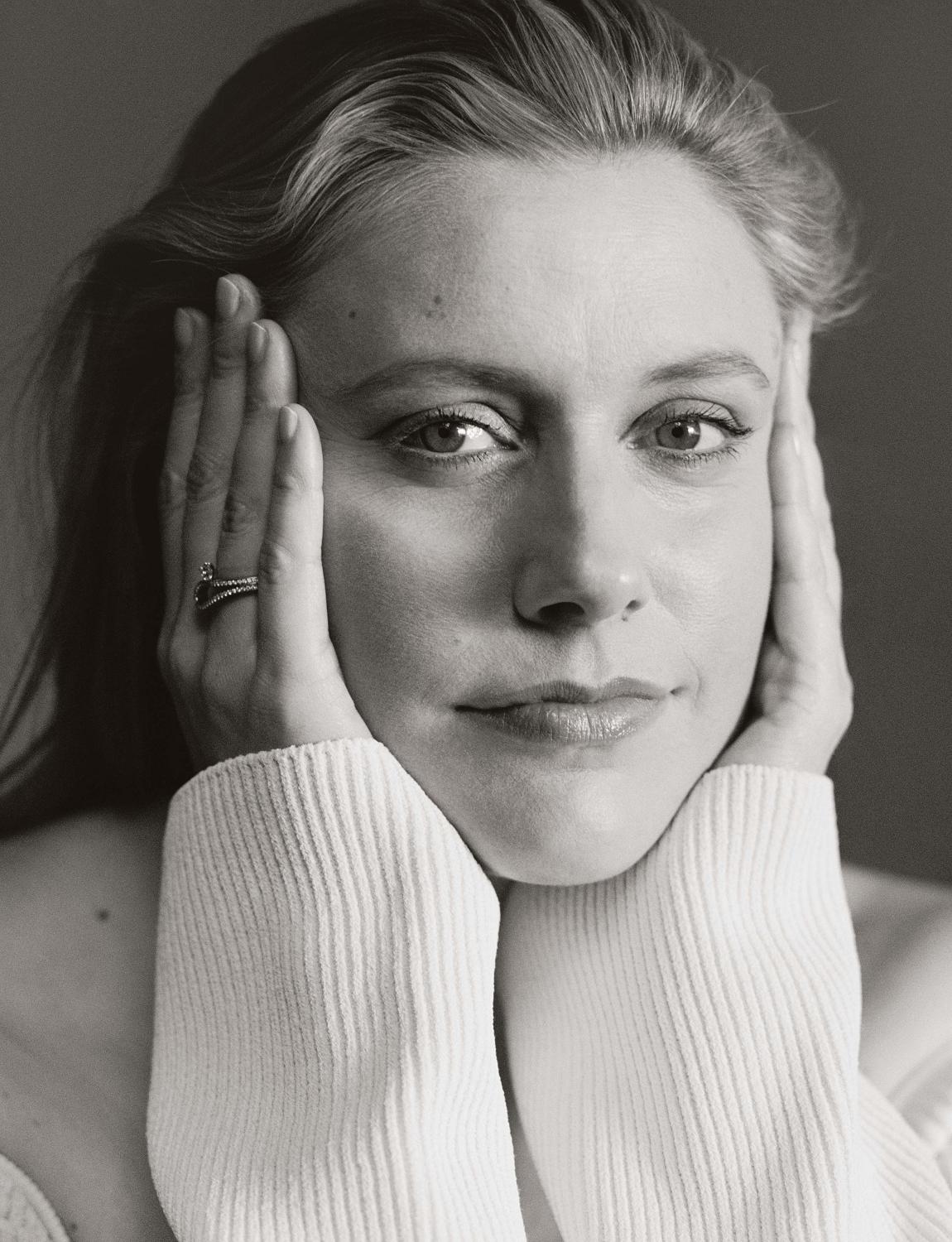
Greta is wearing an ivory viscose Pia dress by KHAITE, and a pink-gold diamond-paved Serti Inversé ring by REPOSSI. In the previous images, Greta wears a black viscose Devon dress by KHAITE.
White Noise, Baumbach’s adaptation for Netflix of Don DeLillo’s famously strange novel, is Greta’s 35th acting credit. While preparing to play Babette Gladney, a housewife with certain secrets, she exclusively read books about death. She also refused to have her nails done by the make-up department. “They said, ‘Oh, we can do the acrylic nails in the make-up trailer,’ and I said, ‘No, no. I’m going to go to get them done.’ So I’d go to the nail salon, just like the character would go to the nail salon, every weekend.”
On set for Lady Bird, Greta wore only men’s brogues. In realising her screenplay for Little Women, she had a particular group of visual obsessions. “I had a very specific set of paintings I was looking at. There were Winslow Homers of these two girls on the beach. And there were specific photographers, like Julia Margaret Cameron, who was taking portraits of girls in the 1860s that look like girls that you knew.”
While making Barbie, she alternated between blue and black jumpsuits, except on Wednesdays, when she wore a pink one. “It was something Margot [Robbie] started: ‘On Wednesdays, we wear pink.’” Everyone would do it, including the crew.”
“I think if you do things the first week [of production] and the boat’s on the water and things are going OK, then you’re like, Well, I have to keep doing that stuff,” she explains. “What’s compelling about each project is that you’re sort of stepping into a world that has its own requirements.” The jumpsuits were almost always paired with Nike Air Force 1s, but “then it was really hot when we were shooting in LA, so I decided to wear Birkenstocks – which was a big drama – because I knew my feet were going to be too hot. And actually, America Ferrera said to me, ‘It’s so weird to see you with different shoes.’ I was like, ‘I know. I’m terrified of what it’s doing to the movie.’”
All this is about commitment to the film, obedience to it, she says. “This makes me sound sort of mystical, but I do think movies want to be something. They have their own sense of what they want to be. With each movie I step into, I think, What’s the language again? What does this movie want? What’s the right medium for it? What’s the right format for it? I mean, it’s like, a thing you do early with your DOP [director of photography] is ask, ‘What’s the right aspect ratio?’ It seems like a small thing, but it’s not. When I first was talking to Rodrigo Prieto, who shot Barbie, we were talking about how the dolls are vertical and film is more horizontal. And he was like, ‘Well, what if we shot it in two-to-one, which is the aspect ratio that they shot Jurassic Park in,’ because dinosaurs are also – you need them to have vertical height, more headroom. And I was like, ‘Oh, that’s perfect.’ The way to shoot dinosaurs or Barbie dolls is two-to-one.”
It is this attention to detail that Margot Robbie comments on. “She understands people and cares about people in a way I’ve never seen other directors do,” she writes. “But she’s also a true film lover. She has such a reverence for the filmmakers of the past but also has her finger on the pulse of the world we live in today. And because of that she can in the same breath reference a film from the 1930s and a TikTok that went viral several months ago and somehow find the common link and how it’s relevant to the scene you’re shooting.”
Late last year, a trailer for Barbie had a cultural moment in its own right, pastiching as it did the famous opening scene of Stanley Kubrick’s 2001: A Space Odyssey, complete with Strauss’s Also sprach Zarathustra. Except, instead of early humans in the wilderness, we see girls playing with dolls, who, rather than being visited by an alien monolith, are greeted by an oversized Barbie.
So what else can Greta tell me about the film? “I will say it’s funny,” she says. “I mean, I hope, I think, it is funny. I find it funny. I know they’re funny.” She means her cast, which also includes Will Ferrell, Issa Rae, Ncuti Gatwa and Helen Mirren.“The wonderful thing about the collaborative nature of it is, my actors completely transformed what I thought I was doing. It was the most joyful experience, and coming to work every day was like Christmas morning every morning.” Ryan Gosling, speaking to Jimmy Fallon on The Tonight Show not long after an image of him as Ken, buffed and in denim, had been released, admitted to texting Greta the minute he was offered the part, insisting he would strike a blow for Barbie’s overlooked sidekick. “I shall be your Ken,” he said, “for his story must be told.”
Was Greta apprehensive about the less-than-ideally-feminist credentials of the Barbie brand? “I think it’s Walter Benjamin who said that there’s no tool without blood on it. I think kind of anything you look at, you’re going to have the side of it that has something that makes you question it. Certainly. Barbie, just like anything that exists that’s a human creation, it’s got some stuff that’s not so perfect about it.”
Strangely for a cultural franchise so American in aura, a lot of Barbie was filmed at Leavesden studio, just outside London. Greta and her son, Harold, stayed in Notting Hill during that time. Margot Robbie tells me that the cast and crew would often take over the local Electric Cinema. “Greta would pick a movie that in some way related to our movie, and we’d all go and watch it.” Greta, a dedicated city walker, loves London for its size, its inexhaustibility. “This is almost sacrilege to say in New York, but walking in London is extraordinary because you can do it for hours. I mean, it’s enormous. It’s ridiculous.”
Greta loves her job. She loves it so much that she’ll be deadlifting weights after this interview so as to safeguard her ambitions for the 2060s. “I think I’m prematurely worrying about this,” she says, “but I want to make movies up until my 80s, and working as a director is a very physical thing.” Given her pregnancy, her regime, which combines gymnastics and strength training, is lighter than it once was. But it is also connected with motherhood in that she began to work with her trainer following Harold’s birth in 2019. “I said I wanted to be able to deadlift my body weight. Because it feels like psychologically you should be able to pick yourself up. It felt like a simple but psychologically important thing to be able to do.”
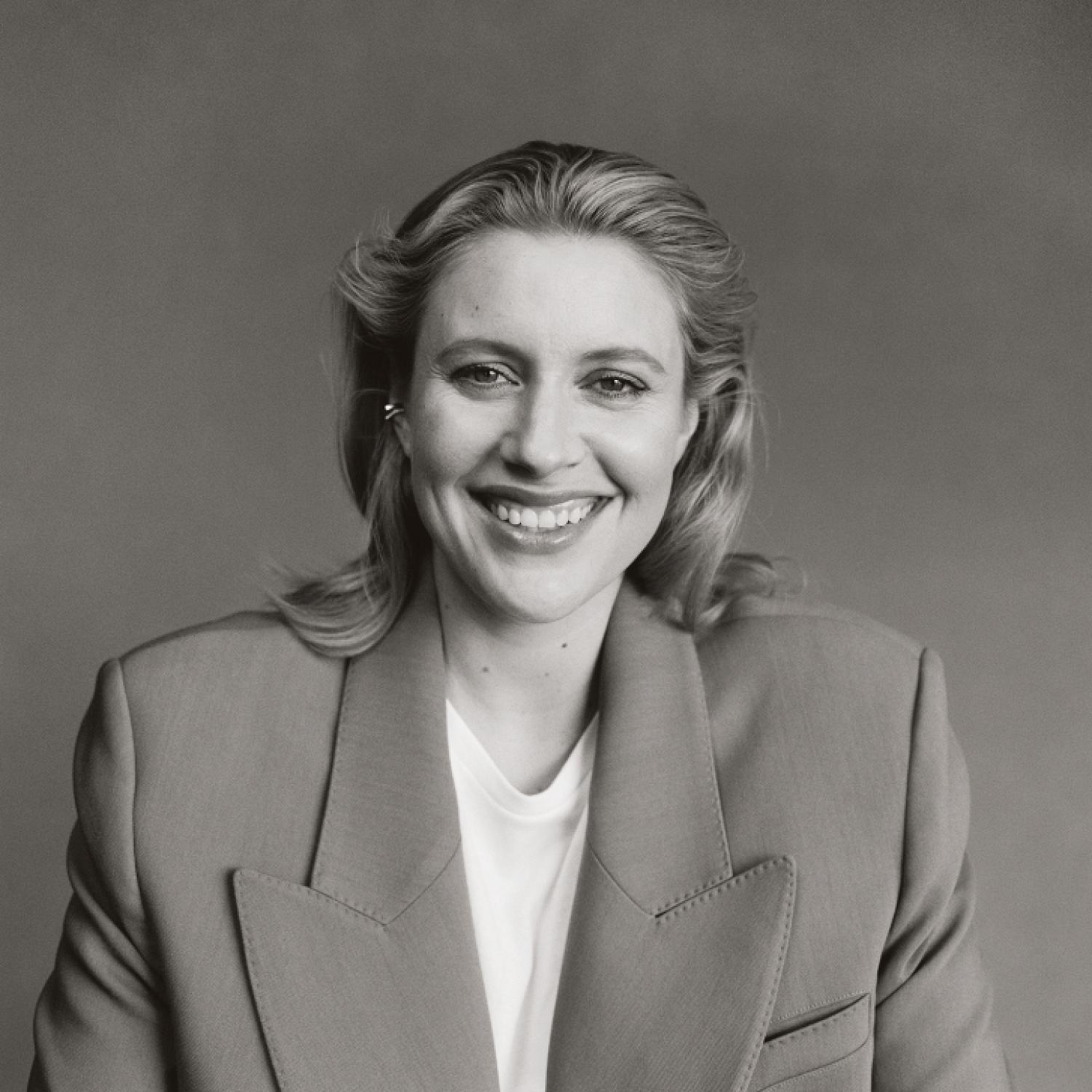
Seb EminaSeb Emina is the former editor in chief of The Happy Reader, and a contributing editor to The Gentlewoman. He divides his time between London and Paris. Subscribe to his brilliant newsletter here. read more Portraits by
Jody RogacBorn in England and raised in Vancouver, the photographer Jody Rogac graduated with a BFA in Visual Arts from the Emily Carr University, Vancouver. Her work has been exhibited at Ed Varie in New York and Paris, and published in magazines such as Frieze, i-D, Monocle, The New York Times Magazine and Rolling…read more
Styling: Jessica Diehl. Hair: Tamara McNaughton at Bryant Artists. Make-up: Brigette Reiss-Andersen at A-Frame Agency. Manicure: Nori at See Management. Set design: Alicia Sciberras at CLM. Tailor: Susan Balcunas. Lighting: Justin Leveritt. Photographic assistance: Amelia Hammond, Joshua Mathews. Styling assistance: Devin Hershey. Hair assistance: Shoshana Contaste. Post-production: Studio RM. Production: Second Name.
This profile was originally published in The Gentlewoman nº 27, Spring and Summer 2023.THE GENTLEWOMAN

No comments:
Post a Comment